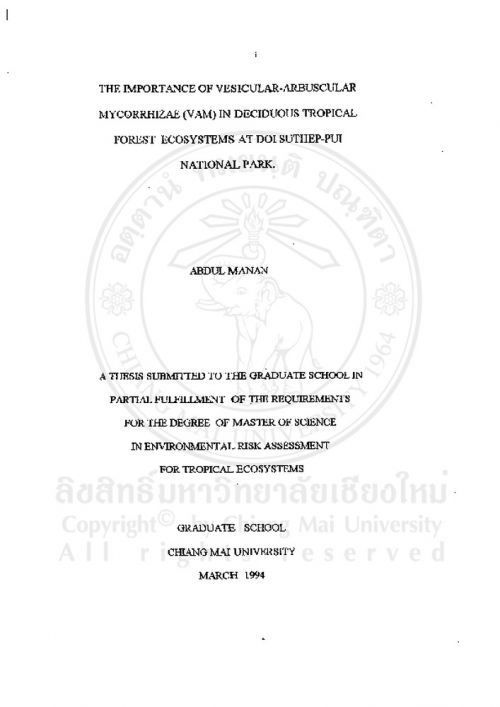The Importance of Vesicular-Arbuscular Mycorrhizae (VAM) in Deciduous Tropical Forests

ABSTRACT: This study determined the prevalence of vesicular-arbuscular mycorrhizal infection amongst leguminous trees in Doi Suthep-Pui National Park and investigated the effects of VAM on germination and growth rate of Albizia odoratissima.
Ten tree species of the family Luguminoseae were selected for determination of VAM association. Three soil samples from around three adult trees of each species were collected for determination of VAM spore density, using the wet sieving and decantation method and 6 seedlings of each species were collected, for determination of infection rate, using a staining technique. Erythrina subumbrans was selected at different altitudes to examine the relationship between altitude and VAM. Soil moisture, pH, field capacity and nutrients were analyzed, to relate VAM abundance with soil properties. In addition, slope, canopy cover and microhabitat characteristics were recorded, to relate VAM association with environmental parameters. A pot experiment was undertaken with the following treatments: Ao (sterilized soil without Glomus microcarpus inoculum); A1 (sterilized soil with 5g G. microcarpus inoculum/kg soil); A2 (sterilized soil with 10g G. microcarpus inoculum/kg soil) and A3 (sterilized soil with 15g G. microcarpus inoculum/kg soil). For each treatment, 100 seeds of Albizia odoratissima were germinated to evaluate the effect of G. microcarpus on germination rate and to evaluate VAM's effect on the growth of Albizia odoratissima. The experiment had a randomized complete block design with 4 replications.
All tree species were associated with VAM. The higher the elevation; the fewer VAM spores were observed (range 104.11 - 169.67 per 50g soil). The number of VAM spores was associated with environmental parameters and soil properties. The strongest correlation was with soil pH (r=-0.460). Both soil moisture and soil pH were positively correlated with seedling root-infection rates.
G. microcarpus had no significant effect on germination rate of Albizia odoratissima. Inoculation significantly increased seedling growth 1, 2 and 3 months after inoculation (p=0.05). In addition, VAM also significantly increased seedling dry weight (p = 0.05) and the highest increase was obtained with 15 g VAM inoculum/kg soil (A3). Thus, VAM can improve the growth of seedlings of A. odoratissima.
Overall, it can be concluded that VAM could play an important role on the growth and survival of trees in tropical deciduous forest ecosystems, but more experiments with a wider range of tree species are needed.
